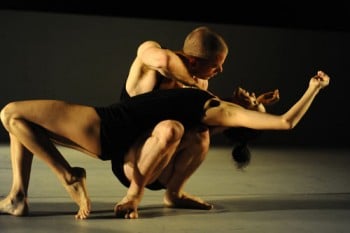Adelaide Festival: Sadeh21

Israel’s Batsheva Dance Company were last in Adelaide to present two stunning works, Anaphase and Mabul, as part of Barrie Kosky’s groundbreaking 1996 Adelaide Festival of Arts, so their return to play Adelaide Festival in 2014 has been long-awaited.
Choreographed by Ohad Naharin, Sadeh21 features 18 of the company’s wonderfully talented dancers – nine females and nine males – and is a wonderful journey into the world of contemporary dance. It utilises a technique Naharin has devised known as Gaga (nothing to do with Lady Gaga) which is the combination of dance movement combined with sensuality. And Sadeh21 is a very sensual work.
The Festival Theatre stage was stark white with four columns each side and a two-metre high backdrop which served perfectly to showcase the talents of the dancers who were mostly dressed in grey and black (T-shirts, vests and shorts were the order of the day) with an occasional splash of colour.
The piece began with each of the dancers performing solo and it gave a wonderful hint of the exceptional dancing yet to come with some large ensemble pieces involving everyone, subtle duets and some further solo work. There is also a touch of ballet about the performers – following one of the movements, a number of female dancers gracefully pirouette off stage – and in some ways Sadeh21 could be seen as a highly contemporary ballet piece.
[pull_left]in some ways Sadeh21 could be seen as a highly contemporary ballet piece . . . maybe it’s all part of a grand plan by Naharin to leave audiences feeling slightly bewildered about what they have just witnessed.[/pull_left]
It is also not without humour and there are a number of muffled guffaws from the audience when the male dancers take to the stage in black gowns. The white backdrop is also used to mark each section with the words Sadeh1, Sadeh2, Sadeh3, and so on being screened. There are again, some laughs from the audience when Sadeh6, which comes about three-quarters through the piece to indicate there are another 15 to sit through, is followed by signage indicating Sadeh7-18 before the final three sections bring the work to a close.
There is also much music that ranges from works by Brian Eno, Harold Budd and David Darling through to Angelo Badalameni’s Dianne & Camilla from his Mullholland Drive film score.
I’m not sure if Sadeh21 tells any particular story – Sadeh is a Hebrew word for ‘field of study’ – but if it’s about anything it’s about relationships and in one section, the dancers are tossed away from one to another as if someone is casually discarding a lover. The miming of a machine gun by one of the male dancers also indicates that it may also involve some kind of turmoil.
Sadeh21 ends with a bare stage with one of the male dancers standing on top of the two-metre high backdrop before slowly falling backward. Slowly but surely, all the dancers clambour up to the backdrop from behind and then drop into the abyss below in various ways. Some leap and some just slowly fall while a couple hold hands and then leap together into the unknown.
The words ‘The End’ were then shown on the white backdrop before being followed by a long list of credits. I felt the audience were then waiting for the dancers to return to the stage to take their bows before they would explode into much applause and perhaps a standing ovation. So it was all a bit of an anti-climax when the house lights came on and this didn’t occur and patrons slowly filtered out.
But maybe it’s all part of a grand plan by Naharin to leave audiences feeling slightly bewildered about what they have just witnessed.
